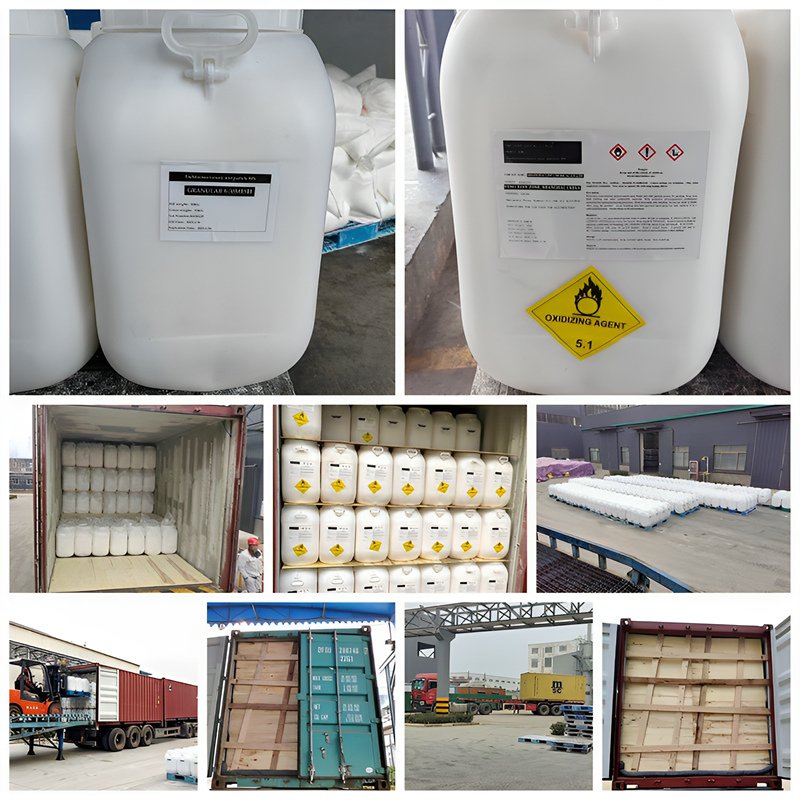Sodium Hypochlorite 12.5-Name Of NaOCI
Sodium hypochlorite is a common and important disinfectant and bleach. It has strong oxidizing properties and can effectively kill microorganisms and remove stains, widely used in water treatment, cleaning and disinfection, the food industry, and other fields.
| Appearance | colorless, transparent, or slightly yellow solution, with a chlorine-like smell |
|---|---|
| Solubility | easily soluble in water, its aqueous solution is alkaline |
| Stability | unstable, easily decomposed by light or heat, generating sodium chloride and oxygen |
| Density | primary industrial standard: about 13%. |
| Oxidizing property | a strong oxidant that can promote many chemical reactions |
Specific Applications of Different Concentrations of Sodium Hypochlorite Solutions
Sodium hypochlorite solutions with different concentrations vary in oxidizability and disinfection capabilities, which leads to differences in their usage. Here is a detailed introduction:| Density | Applications | Precautions |
|
10%-13% (high-concentration) |
Applied in industry, bleaching like textile fabrics and pulp bleaching. Also used in industry wastewater treatment to decompose pollutants and meet discharge standards. Also applied in the food industry (e.g., coffee) in diluted form to ensure safety and quality. Read more → | Due to its high concentration and strong oxidizing and corrosive properties, it is suggested that people wear protective gear, operate in well-ventilated areas, and dilute and use it according to specific processes. |
| 5%-8% (medium-concentration) | Widely used for disinfection in hospital environments, medical equipment, and public places to kill germs and inhibit their spread. | Dilute it appropriately based on the disinfection object and the degree of contamination, and clean it to remove any residues after disinfection. |
| 0.5%-2% (lower concentration) | Applied for household disinfection of items, environments, and in the food processing industry for equipment and packaging materials. | Avoid long-term skin contact and rinse disinfected items to prevent residue. |
| 0.05%-0.2% (low-concentration) | Employed for disinfection in the drinking water, breeding industry, and agricultural seed to ensure safety and prevent diseases. | Strictly control the dosage to meet sanitation standards when disinfecting drinking water and avoid excessive residual chlorine, which can harm human health. |
Why Choose Linp Chemical?
-
Stable Supply: Our monthly production capacity ensures a long-term and large-volume supply.
-
Quality Guarantee: Produced under strict international standards, consistent concentration, and reliable performance.
-
Flexible Packaging: Multiple packaging options, supporting OEM and customized labels for secondary distribution.
-
Export Expertise: Familiar with IMDG regulations, professional export service to global markets.
Customized Packaging Options
-
25L plastic drums
-
200L HDPE drums
-
1000L IBC tanks
(Customized packaging & OEM service available for distributors and resellers)
Supply & Export
-
Consistent supply: Reliable long-term partnership for distributors
-
Export-ready: Fully compliant with IMDG shipping regulations
-
Flexible service: Multiple batch sizes and packaging options
Tell us your requirements, and our team will provide the best Sodium Hypochlorite solution for your business.
• Personal protection:
Sodium hypochlorite is highly oxidizing and corrosive. When using it, you should wear protective gloves, masks, and other protective equipment to avoid contact with skin and eyes. If you accidentally contact it, you should immediately rinse it with plenty of water and seek medical attention in time.
• Proper dilution and use:
Strictly dilute it according to the requirements of the product manual and avoid using metal containers. When disinfecting, choose the appropriate concentration and action time; after disinfection, wipe or rinse the disinfected items with clean water to remove residual sodium hypochlorite and reduce potential harm to the human body.
• Keep ventilation:
When using sodium hypochlorite indoors, you should maintain good ventilation conditions, open doors and windows, accelerate air circulation, and discharge the volatile gas outdoors as soon as possible to reduce the concentration of sodium hypochlorite in the air.
• Proper storage:
It should be stored in a cool and ventilated warehouse, away from fire and heat sources, and avoid direct sunlight. It cannot be mixed with acidic substances for storage, otherwise, leakage may occur and produce toxic chlorine gas.
• Child protection
Keep sodium hypochlorite out of the reach of children to prevent them from accidentally taking or misusing it and causing harm.
Packaging
Typically, we offer 50kg barrel packaging for the safety and convenience of storage and transportation. But we also provide custom packaging solutions based on the customers’ specific requirements.
The barrels we use to store the chemicals are made of high-density polyethylene (HDPE) plastic. These barrels are highly resistant to chemical corrosion and can resist the corrosion of acids, alkalis, salts, and most chemicals. The barrel wall thickness is approximately 2-5mm, and the barrel cover uses a sealing cover to prevent chemical leakage.
The labeling requirements for the barrel outer packaging completely follow GHS requirements, clearly identifying the hazards of chemicals, including label colors and symbols (such as corrosive, flammable, environmental hazard symbols, etc.). Necessary safety measures are also provided, such as treatment methods and first aid measures after contact with chemicals.
When packing, our factory operators will use forklifts to move the neatly stacked barrels of chemicals into the carriage. Each box of goods has a fixed weight limit to ensure that it is not overloaded. In addition, each layer is equipped with partitions to reduce friction between barrels.
Transportation
Typically, we use the sea transportation. But all the packaging materials are moisture-proof, waterproof, and corrosion-resistant, which can ensure the stability of chemicals and prevent leakage or reaction.
All packages are clearly noted with dangerous goods identification and safety data to meet international transportation regulations during transportation, storage, and operation, and to ensure personnel safety and environmental protection during transportation.
Meanwhile, sea transportation can accommodate a large amount of goods, especially for chemicals that are heavy and large in volume, and th etransportation cost per unit of goods is lower.
In addition, sea transportation has a wide transport network, and almost all ports can be used for sea transportation. Its transportation cycle is also relatively stable and highly secure.




